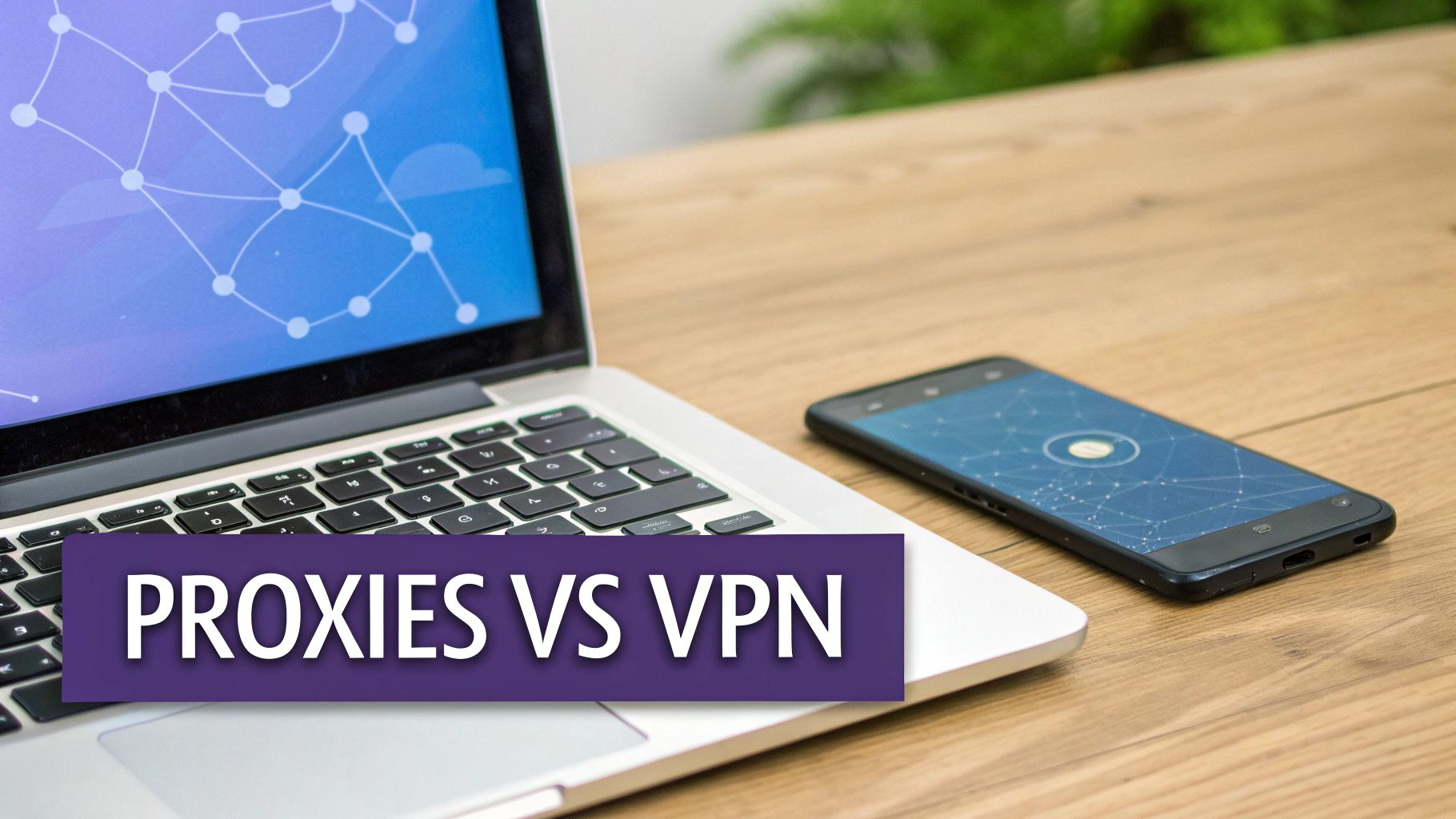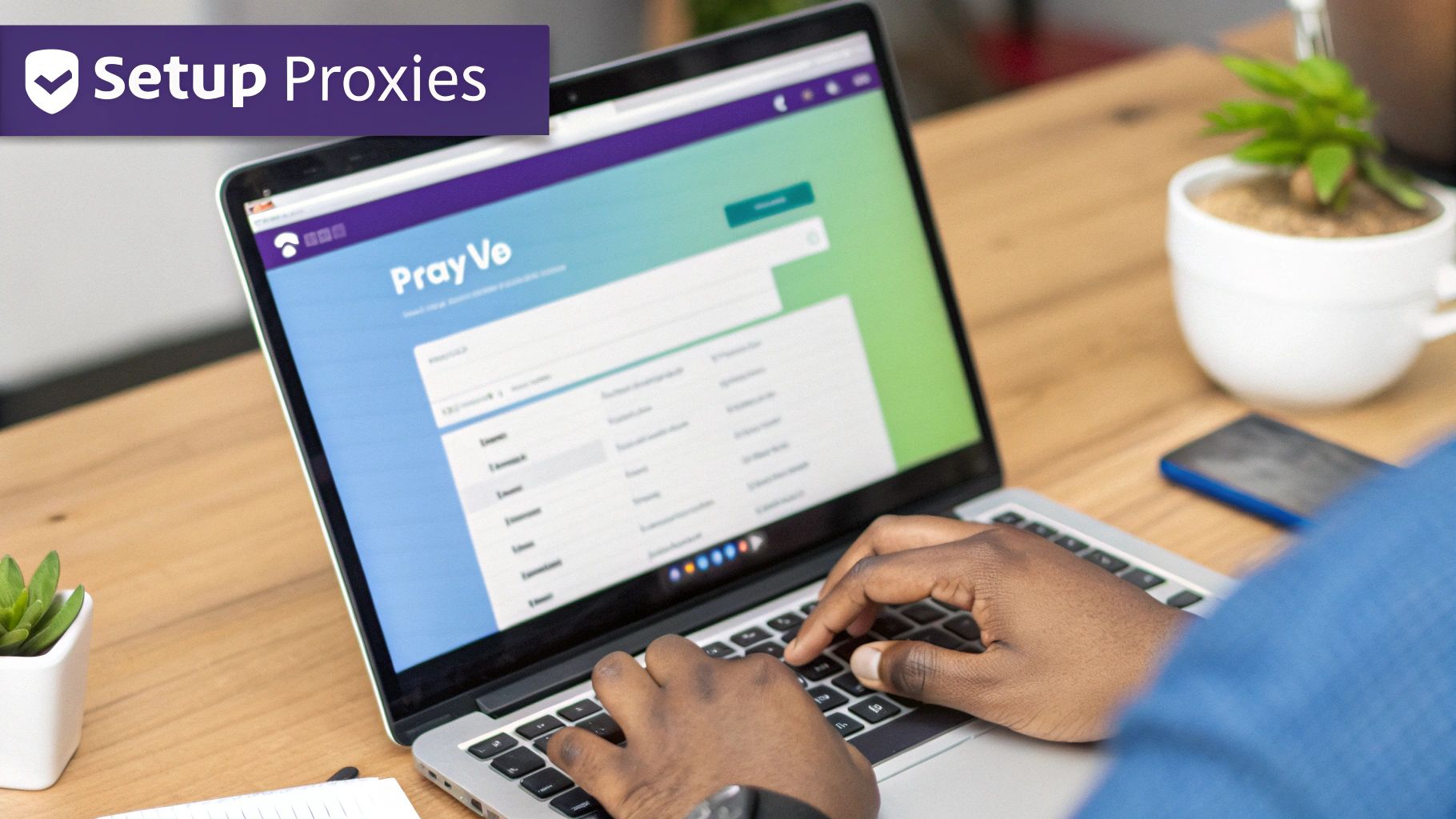Before we dive into how to get around an IP ban, it’s worth understanding why they happen in the first place. Think of an IP ban as a website’s self-defense mechanism. It’s a direct response to activity that the site’s servers flag as suspicious, from sending too many requests to breaking its terms of service. Knowing the root cause is the first step to finding a solution—and making sure you don’t get blocked again.
Why Websites Block Your IP Address

We’ve all been there. You try to load a page and are met with that frustrating “Your IP has been banned” message. It’s a digital dead end.
But this isn’t random. Websites use IP bans to protect their servers, users, and data from what they see as a potential threat. For example, refreshing a sneaker release page hundreds of times a second looks a lot like a denial-of-service attack to an automated system, triggering an instant ban. Other times, the reasons are a bit more complex.
Common Triggers for an IP Ban
Websites are constantly monitoring traffic, and certain patterns will almost always raise a red flag. Let’s look at some of the usual suspects that get people’s IP addresses blocked.
To give you a clearer picture, here’s a quick breakdown of the most common reasons websites pull the plug on an IP address.
Common Reasons for an IP Ban
| Reason for Ban | Common Scenario | Platform Example |
|---|---|---|
| Excessive Request Rates | An automated script hits the server hundreds of times per minute to collect pricing data. | E-commerce sites like Amazon or airline booking portals. |
| Suspicious Login Attempts | Multiple failed login attempts are made from the same IP address in a short time. | Social media platforms like Facebook or online banking portals. |
| Terms of Service Violations | A user creates multiple accounts to upvote their own content or posts spam comments. | Community forums like Reddit or comment sections on news sites. |
| Geographical Restrictions | A user from an unsupported country tries to access a region-locked streaming library. | Streaming services like Netflix or Hulu. |
These are the classic triggers, but the game has evolved quite a bit.
Beyond a Simple IP Block
Modern websites have moved far beyond just blacklisting an IP address. Major digital platforms now use multi-layered systems to enforce bans and stop people from getting around them.
Take e-commerce giants like Amazon and Walmart. They combine IP-based rules with advanced browser fingerprinting, behavioral analytics, and machine learning to spot suspicious traffic. These systems analyze everything from request rates and session behavior to your device details, all to detect any attempt to bypass a block.
Key Takeaway: An IP ban is rarely just about your IP address anymore. Websites analyze a collection of data points to determine if traffic is legitimate, making a robust bypass strategy essential for consistent access.
Choosing the Right Tool: Proxies vs. VPNs

When you hit an IP ban, your first thought might be to grab a VPN or a proxy. While both tools can mask your real IP address, they’re built for completely different jobs. Picking the wrong one is like trying to use a hammer when you really need a screwdriver—you might make some progress, but you’re not going to get the job done right.
A Virtual Private Network (VPN) is what most people reach for first. It routes all your device’s internet traffic through a single, encrypted server. This swaps your IP for the server’s, which is perfect for personal privacy or watching another country’s Netflix library.
But that single-IP approach is exactly where VPNs fall short for more serious tasks. If you’re managing multiple social media accounts or scraping data, every single action you take comes from one IP address. Once that IP gets flagged, you’re blocked again. Back to square one.
The Limitations of VPNs for IP Bans
VPNs are great for what they are, but they just can’t keep up with sophisticated IP blocking systems. While over 35% of internet users in major markets use VPNs to get around restrictions, they’re often the wrong tool for professional use. The encryption and rerouting process alone can slash your internet speed by 10-30%, which is a deal-breaker for any data-intensive work. You can find more stats on VPN effectiveness over at crawlbase.com.
Key Takeaway: VPNs give you a quick, one-time IP change, but they don’t have the scale or flexibility needed to consistently dodge IP bans for business or data collection. Their shared IPs are often easily detected and already on blacklists.
Why Proxies Are a Superior Solution
This is where proxies—especially residential proxies—completely change the game. Instead of one server, a proxy service gives you access to a huge pool of IP addresses, sometimes numbering in the millions. These IPs come from real, everyday devices in homes all over the world, making your connection requests look 100% genuine.
The difference is night and day. Imagine you’re scraping product prices from a major e-commerce site. With a good proxy setup, you can rotate to a new IP address with every single request. One request might come from Chicago, the next from London. To the website’s security, it just looks like thousands of individual shoppers browsing normally.
This dynamic rotation makes it practically impossible for a website to identify and block your activity. You can explore the benefits of residential proxies to see how it works in detail. By spreading your requests across a massive network of IPs, you just blend into the crowd, becoming invisible and maintaining uninterrupted access.
Implementing Proxies to Regain Access

This dashboard from a provider like IPFLY shows just how straightforward it is to manage your proxy connections and settings. With a clear interface, you can quickly grab the credentials you need to get your new IP address up and running.
Once you’ve been blocked, theory goes out the window. Practical steps are all that matter. This is where you move from understanding IP bans to actively working around them. The key is to select the right tool for the job and configure it correctly to ensure your new connection looks completely authentic.
Your first decision is choosing the right type of proxy, and this choice directly impacts your success rate. For instance, if you’re conducting market research on a competitor’s e-commerce site, you need to appear as a genuine shopper, not a bot.
- Residential Proxies are perfect for this. They use real IP addresses from actual internet service providers, making your traffic indistinguishable from that of a regular home user.
- Datacenter Proxies are faster and cheaper, but they come from commercial servers. They are far more easily detected and best suited for tasks on websites with less strict security.
For bypassing a tough IP ban, choosing a residential proxy is almost always the safer bet.
Setting Up Your Proxy Connection
After picking your proxy type, it’s time for implementation. Whether you’re using a web browser, a custom script, or a third-party application, the setup process involves directing your traffic through the proxy server. This requires specific credentials that your provider will give you.
Using a service like IPFLY as an example, you’ll typically receive these details:
- Proxy Host/Endpoint: This is the server address you will connect to (e.g.,
proxy.ipfly.net). - Port Number: This tells your software which “gate” on the server to use (e.g.,
8000). - Username and Password: These are your unique credentials to authenticate the connection.
With these details in hand, you can configure your software. In a browser like Chrome or Firefox, you can enter this information directly into the network or proxy settings. For more advanced tasks, like web scraping with a Python script, you would integrate these credentials right into your code’s request headers.
Verifying Your New IP Address
Configuration is only half the battle; verification is where you confirm it worked. Before you jump back into your activities, you must confirm that your IP address has actually changed and that the proxy is working as intended.
The most common point of failure isn’t the proxy itself, but a simple misconfiguration. Forgetting to save settings or a typo in the endpoint address can leave your real IP exposed. Always double-check your setup.
To verify, just visit an IP-checking website like whatismyipaddress.com or ipleak.net. The IP address displayed should match the location and details of your proxy, not your actual location. So, if you’ve set up a proxy in Germany, the site should confirm your connection is coming from there.
Once confirmed, you can confidently get back to work, knowing you’ve successfully learned how to bypass IP bans and have regained access.
Mastering IP Rotation to Stay Undetected

Simply having a proxy isn’t enough; the real secret to staying off blocklists is a smart IP rotation strategy. If you stick with the same proxy IP for too long, you’re sending a huge red flag to any modern security system. It just doesn’t look like normal human behavior.
The whole point of IP rotation is to make your automated activity blend in, making it indistinguishable from regular user traffic. This is where residential proxies really shine. Since they use IPs from real home internet connections, they already look legitimate. Adding an intelligent rotation strategy on top is what makes your operations nearly invisible.
High-Frequency Rotation for Data Gathering
For high-volume tasks like web scraping, one of the most effective tactics is to rotate your IP address after every single request. It’s aggressive, but it works wonders.
Think about scraping thousands of product prices from a major e-commerce site. If all those requests came from one IP, you’d be shut down in a matter of minutes.
Here’s a practical example of how it works:
- Request 1: Your script asks for
product-A.htmlusing an IP from New York. - Request 2: The proxy service automatically assigns an IP from Los Angeles to get
product-B.html. - Request 3: A new IP from Chicago is used to request
product-C.html.
To the website’s servers, this looks like thousands of individual shoppers browsing their catalog. This is how you fly under the radar and avoid those frustrating rate limits that can bring a large-scale data job to a grinding halt.
Using Sticky Sessions for Complex Tasks
While rapid-fire rotation is perfect for scraping, it completely falls apart for tasks that need a consistent session. Imagine trying to complete a checkout process or fill out a multi-page form. If your IP changes between adding an item to your cart and entering your payment info, the site will almost certainly flag it as suspicious activity and block you.
This is exactly why “sticky sessions” were invented.
A sticky session lets you hold onto the same proxy IP for a specific amount of time—like 10 or 30 minutes. It gives you a stable identity, just long enough to complete your workflow without raising any alarms.
A great practical example is managing a social media account. You’d use a sticky session to log in, browse the feed, and make a post. This perfectly mimics how a real person would use the platform from their home network. Once you’re done, the session expires, and you get a fresh IP for whatever you need to do next.
If you’re ready to put these strategies into action, you can explore our simple proxy integrations to get set up quickly.
IP Rotation Strategy Comparison
Choosing the right IP rotation strategy is all about matching it to the job at hand. A method that works perfectly for scraping will get you blocked instantly when trying to manage an account. To make it clearer, here’s a breakdown of the common strategies and where they excel.
| Strategy | Best For | How It Works | Potential Drawback |
|---|---|---|---|
| High-Frequency Rotation | Large-scale web scraping, price monitoring, ad verification. | A new IP is used for every single request or connection. | Fails for tasks requiring a consistent login session. |
| Sticky Sessions | Account management, filling out forms, e-commerce checkouts. | The same IP is maintained for a set duration (e.g., 10, 30 mins). | Can be flagged if the session is kept active for an unnaturally long time. |
| Manual Rotation | Testing specific geolocations, one-off tasks. | You manually select and switch IPs as needed from a list. | Not scalable for automated or large-volume tasks. |
Ultimately, the best approach is a flexible one. A good proxy service lets you switch between high-frequency and sticky sessions depending on what you’re doing, giving you the best of both worlds.
Playing by the Rules: Ethical Bypassing and Best Practices
Getting past an IP ban isn’t just a technical challenge—it’s about being smart and responsible to ensure you maintain access long-term. This isn’t about crashing gates or causing trouble. It’s about respectfully accessing public information in a way that doesn’t disrupt the website you’re visiting.
Think of it this way: your goal is to blend in with regular human traffic, not stick out like a sore thumb. Adopting an ethical mindset means you’re treating the site’s resources with care. This isn’t just good manners; it’s the most effective strategy for staying under the radar.
The Foundation of Responsible Access
Before you even think about sending an automated request, your first port of call should always be the website’s robots.txt file. You can usually find this simple text file by typing domain.com/robots.txt into your browser. It’s the site owner’s rulebook for bots, clearly outlining which pages and directories are off-limits.
Ignoring these rules is the fastest way to get your entire IP block blacklisted. Respecting them is a fundamental part of ethical data access and shows you’re playing fair.
Another critical piece of the puzzle is throttling your request rate. Blasting a server with hundreds of requests a second might feel efficient, but it’s a massive strain on their infrastructure and a blaring red flag for any security system.
An actionable tip is to introduce random delays between your requests—anything from 2 to 10 seconds is a good start. In a Python script, this is as simple as adding
time.sleep(random.uniform(2, 10))between your requests. This mimics the unpredictable way a real person browses, dramatically lowering your odds of being flagged.
Blending In with Authentic Headers
Beyond just managing your speed, your requests need to look like they’re coming from a real person using a standard web browser. This all comes down to configuring your request headers, especially the User-Agent.
The User-Agent is just a string of text that tells the server which browser and operating system you’re using. Sending a request with a generic, outdated, or missing User-Agent is a dead giveaway that you’re running a script.
To fly under the radar, always use a list of common, up-to-date User-Agent strings and rotate them with your requests.
- Chrome on Windows:
Mozilla/5.0 (Windows NT 10.0; Win64; x64) AppleWebKit/537.36 (KHTML, like Gecko) Chrome/108.0.0.0 Safari/537.36 - Safari on macOS:
Mozilla/5.0 (Macintosh; Intel Mac OS X 10_15_7) AppleWebKit/605.1.15 (KHTML, like Gecko) Version/16.1 Safari/605.1.15
When you combine a legitimate User-Agent with other standard headers like Accept-Language and Referer, your traffic becomes almost indistinguishable from a genuine visitor. This attention to detail is what separates a script that gets banned in minutes from a sustainable, long-term operation. At the end of the day, ethical bypassing is just smart bypassing.
Frequently Asked Questions
Jumping into the world of IP bans and proxies can feel a bit overwhelming. Even with a solid plan, you’re bound to have questions about the legal side of things, how detection works, and which tools are actually worth your money. Here are some quick, no-nonsense answers to the most common questions I hear.
Is It Legal to Bypass an IP Ban?
This is a bit of a gray area, and the answer really boils down to why you’re doing it and where you’re located. On its own, using a proxy or VPN is perfectly legal in most places. The tricky part comes in when you look at a website’s Terms of Service (ToS).
If a site’s rules specifically forbid using automation or creating more than one account, then using a proxy to get around that is a clear violation. Will you face legal action? Probably not. But you can bet they’ll permanently block your account and the proxy IP if they catch you.
The real legal red flags pop up if you’re using these tools for sketchy activities like scraping copyrighted content or launching cyberattacks. For legitimate use cases—think market research, checking ad placements, or accessing geo-blocked content you’re entitled to—bypassing a ban is generally a low-risk move.
Can Websites Detect Proxy or VPN Usage?
Oh, absolutely. Many of the bigger websites have gotten incredibly good at sniffing out and blocking traffic from common proxies and VPNs. They keep massive blacklists of IP addresses known to come from datacenters and public VPN services. If you grab a free or super-cheap proxy, there’s a good chance its IP is already on that blacklist.
This is where your choice of proxy provider becomes critical.
Key Insight: Top-tier residential proxies are the undisputed champs for staying under the radar. Their IP addresses come from real home internet connections, making their traffic look identical to that of a regular user. It’s incredibly difficult for websites to spot and block them without risking blocking actual customers.
How Do I Choose Between Residential and Datacenter Proxies?
Your decision here really comes down to two things: your target website’s security level and your budget. It’s the classic trade-off between price and performance.
Here’s a practical breakdown to help you decide:
- Datacenter Proxies: Choose these if your task involves high-volume data collection from websites with basic security. For example, scraping data from thousands of small, independent blogs. They’re fast and cost-effective.
- Residential Proxies: These are essential for interacting with highly-secured platforms or when you need to appear as a genuine local user. For example, managing social media accounts, purchasing limited-edition items, or checking localized search engine results. They offer unmatched authenticity.
When you’re trying to get around a stubborn IP ban on a sophisticated platform, residential proxies are almost always the right call. They give you the authenticity you need to blend in and keep your access stable over the long haul.
Ready to regain access and stay undetected with a reliable proxy solution? IPFLY offers over 90 million real residential IPs to ensure your projects run smoothly. Get started by visiting the IPFLY website today.


